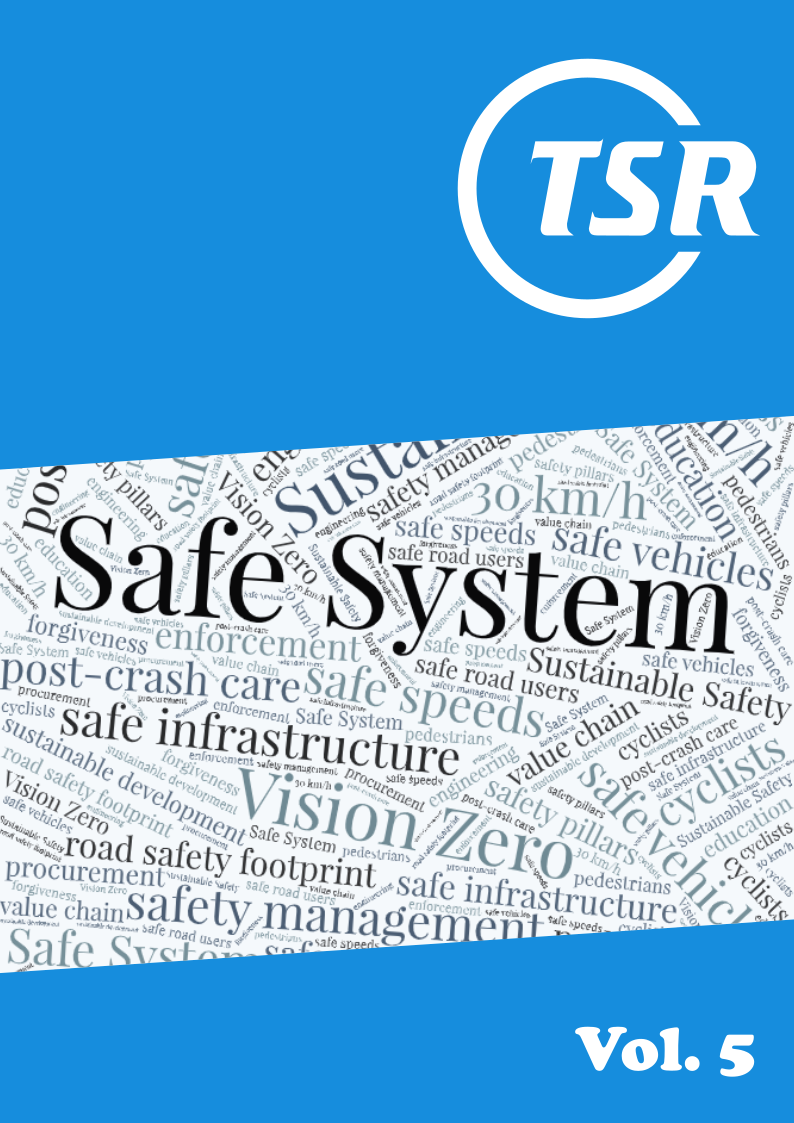Innovation and long-term planning in public policy: the case of national road safety plans in Norway
DOI:
https://doi.org/10.55329/egcn2801Keywords:
commitment, innovation, road safety policy, stakeholder involvement, Vision ZeroAbstract
Vision Zero was adopted as the long-term ideal for transport safety in Norway in 2001. Starting in 2002, national road safety action plans covering a period of four years have been developed. This paper identifies innovative elements in these plans and explores the statistical relationship between innovation and the number of killed or seriously injured road users over time. A statistical relationship is found, but it is noisy and cannot be interpreted as a causal relationship. We show how road safety policy has become upgraded and more systematic over time, and that these developments co-exist with a gradual reduction in number of severe injuries and deaths. Important innovative elements are related to the process of policy development, which now ensures a much broader , consensus and commitment to improving road safety than before the action plans were introduced (i.e. before 2002).
Downloads
References
Allsop, R. E., N. N. Sze, S. C. Wong (2011), ‘An update on the association between setting quantified road safety targets and road fatality reduction’, Accident Analysis & Prevention, 43(3), 1279–1283. DOI: https://doi.org/10.1016/j.aap.2011.01.010
Antonsen, S. (2009), Safety culture: Theory, Method and Improvement (London, UK: CRC Press).
Belin, M.-Å. (2022), ‘Vision Zero in Sweden: Streaming through problems, politics, and policies’, in Edvardsson Björnberg, K., Hansson, S. O., Belin, M.-Å., & Tingvall, C. (eds), The Vision Zero Handbook (Cham, Switzerland: Springer), pp. 267–294. DOI: https://doi.org/10.1007/978-3-030-76505-7_9
Belin, M.-Å., P. Tillgren, E. Vedung (2012), ‘Vision Zero - a road safety policy innovation’, International Journal of Injury Control and Safety Promotion, 19(2), 171–179. DOI: https://doi.org/10.1080/17457300.2011.635213
Belin, M.-Å., A. Vadeby (2022), ‘Speed and technology: different modus of operandi’, in Edvardsson Björnberg, K., Hansson, S. O., Belin, M.-Å., & Tingvall, C. (eds), The Vision Zero Handbook (Cham, Switzerland: Springer), pp. 971–994. DOI: https://doi.org/10.1007/978-3-030-76505-7_37
Bloch, C. (2011), ‘Measuring Public Innovation in the Nordic Countries (MEPIN)’, The Danish Centre for Studies in Research and Research Policy (CFA).
Bloch, C., M. M. Bugge (2013), ‘Public sector innovation— From theory to measurement’, Structural Change and Economic Dynamics, 27, 133–145. DOI: https://doi.org/10.1016/j.strueco.2013.06.008
Chaminade, C., C. Esquist (2010), ‘Rationales for public policy intervention in the innovation process: Systems of innovation approach’, in Smits, R. E., Kuhlmann, S., & Shapira, P. (eds), The Theory and Practice of Innovation Policy (Cheltenham, UK: Edward Elgar Publishing). DOI: https://doi.org/10.4337/9781849804424.00012
Craens, J., K. Frenken, T. Meelen (2022), ‘Mission-oriented innovation policy: The case of the Swedish ‘Vision Zero’ approach to traffic safety’, in van Wee, B., Annema, J., & Köhler, J. (eds), Innovations in Transport (Cheltenham, UK: Edward Elgar Publishing).
Elvebakk, B., I. Storesund_Hesjevoll, T. E. Julsrud (2016), ‘På rett vei: Er myndighetenes trafikksikkerhetsarbeid ekspertstyring og paternalisme? [Heading in the right direction. Is public road safety work paternalism and expert rule?]’, TØI: Institute of Transport Economics (Oslo, Norway), TØI rapport 1491/2016.
Elvik, R. (1979), ‘En teoretisk og empirisk drøfting [A theoretical and empirical discussion]’, TØI: Institute of Transport Economics (Oslo, Norway).
Elvik, R. (1993), ‘Quantified road safety targets: A useful tool for policy making?’, Accident Analysis & Prevention, 25, 569–583. DOI: https://doi.org/10.1016/0001-4575(93)90009-L
Elvik, R. (2001), ‘Quantified road safety targets: An assessment of evaluation methodology’, TØI: Institute of Transport Economics (Oslo, Norway), TØI Report 539/2001.
Elvik, R. (2022), ‘Vision Zero in Norway’, in Edvardsson_Björnberg, K., Hansson, S. O., Belin, M.-Å., & Tingvall, C. (eds), The Vision Zero Handbook (Cham, Switzerland: Springer), pp. 295–306. DOI: https://doi.org/10.1007/978-3-030-76505-7_10
Elvik, R., A. Høye, T. Vaa, M. Sørensen (2009), The Handbook of Road Safety Measures (Bingley, UK: Emerald Group Publishing Limited), Second edition. DOI: https://doi.org/10.1108/9781848552517
Fagerberg, J. (2017), ‘Innovation policy: Rationales, lessons and challenges’, Journal of Economic Surveys, 31(2), 497–512. DOI: https://doi.org/10.1111/joes.12164
Fagerberg, J., & Mowery, D.C. (eds) (2006), The Oxford Handbook of Innovation (Oxford, UK: Oxford University Press). DOI: https://doi.org/10.1093/oxfordhb/9780199286805.001.0001
Grünfeld, L. A., M. Bugge, T. B. Jenssen, P. B. Maurseth, E. Skogli (2016), ‘Innovasjon i offentlig sektor og samfunnsøkonomisk lønnsomhet [Innovation in the public sector and socio-economic profitability]’, Menon Economics, Menon publikasjon Nr. 72/2016.
Hale, A. (2000), ‘Culture’s Confusions’, Safety Science, 34(1–3), 1–14. DOI: https://doi.org/10.1016/S0925-7535(00)00003-5
Hanson, J. (2013), ‘Dynamics of innovation systems for renewable energy technology: The role of post- introduction improvements’, PhD thesis, University of Oslo, Oslo, Norway.
Haukelid, K. (2008), ‘Theories of (safety) culture revisited- an anthropological approach’, Safety Science, 46(3), 413–426. DOI: https://doi.org/10.1016/j.ssci.2007.05.014
Hill, M., F. Varone (2021), The Public Policy Process (Abingdon, UK: Routledge), Eights edition. DOI: https://doi.org/10.4324/9781003010203
Hughes, B. P., T. Falkmer, A. Anund, M. H. Black (2019), ‘The relevance of U.S. Strategic Highway Safety Plans in a future context’, PLoS ONE, 14(10), e0223646. DOI: https://doi.org/10.1371/journal.pone.0223646
ISO (2018), ‘Energy Management’, International Organization for Standradization, ISO:50001, https://www.iso.org/iso-50001-energy-management.html.
Kimiagari, S., S. Keivanpour, M. Mohiuddin, C. Van Horne (2013), ‘The Cooperation Complexity Rainbow: Challenges of Stakeholder Involvement in Managing Multinational Firms’, International Journal of Business and Management, 8(22), 50–64. DOI: https://doi.org/10.5539/ijbm.v8n22p50
Nævestad, T. O. (2010), ‘Cultures, crises and campaigns: Examining the role of safety culture in the managementof hazards in a high-risk industry’, PhD thesis, University of Oslo, Oslo, Norway.
Nævestad, T. O., V. Milch, J. Blom (2020), ‘Økonomisk kjøring i godstransportbedrifter: En studie av implementering og effekter av Miljøstigen for energiledelse [Economical driving in trucking companies: A study of implementation and effects of the Eco Ladder for energy management]’, TØI: Institute of Transport Economics (Oslo, Norway), TØI rapport 1799/2020.
Nævestad, T. O., R. Phillips, I. Storesund_Hesjevoll (2018), ‘How can we improve safety culture in transport organizations? A review of interventions, effects and influencing factors in Transportation Research Part F: Psychology and Behaviour’, Transportation Research Part F: Traffic Psychology and Behaviour, 54, 28–46. DOI: https://doi.org/10.1016/j.trf.2018.01.002
Nowell, L. S., J. M. Norris, D. E. White, N. J. Moules (2017), ‘Thematic Analysis: Striving to Meet the Trustworthiness Criteria’, International Journal of Qualitative Methods, 16(1). DOI: https://doi.org/10.1177/1609406917733847
Prashar, A. (2017), ‘Adopting PDCA (Plan-Do-Check- Act) cycle for energy optimization in energy-intensive SMEs’, Journal of Cleaner Production, 145, 277–293. DOI: https://doi.org/10.1016/j.jclepro.2017.01.068
Smith, K. (2009), ‘Climate change and radical energy innovation: the policy issues’, Centre for Technology, Innovation and Culture, University of Oslo (Oslo, Norway).
Sze, N. N., S. C. Wong, C. Y. Lee (2014), ‘The likelihood of achieving quantified road safety targets: A binary logistic regression model for possible factors’, Accident Analysis & Prevention, 73, 242–251. DOI: https://doi.org/10.1016/j.aap.2014.09.012
Thomas, M. J. W. (2012), ‘A systematic review of the effectiveness of safety management systems’, Australian Transport Safety Bureau, XR-2011-002.
Vadeby, A., Å. Forsman (2018), ‘Traffic safety effects of new speed limits in Sweden’, Accident Analysis & Prevention, 114, 34–39. DOI: https://doi.org/10.1016/j.aap.2017.02.003
Wegman, F. (2017), ‘The future of road safety: A worldwide perspective’, PloS ONE, 40, 66–71. DOI: https://doi.org/10.1016/j.iatssr.2016.05.003
Weijermars, W., I. van Schagen (2009), ‘Tien jaar duurzaam veilig [Ten years of Sustainable Safety]’, SWOV: Institute for Road Safety Research (Leidschendam, the Netherlands), R-2009-14.
Windrum, P. (2008), ‘Innovation and Entrepreneurship in Public Services’, in Windrum, P., & Koch, P. (eds), Innovation in Public Sector Services (Cheltenham, UK: Edward Elgar Publishing). DOI: https://doi.org/10.4337/9781848441545
Published
How to Cite
Issue
Section
Categories
License
Copyright (c) 2023 Rune Elvik, Tor-Olav Nævestad, Vibeke Milch, Markus Bugge, Håkon Endresen Normann, Erland Skogli

This work is licensed under a Creative Commons Attribution 4.0 International License.
Funding data
-
Norges Forskningsråd
Grant numbers 326992












